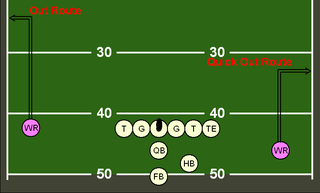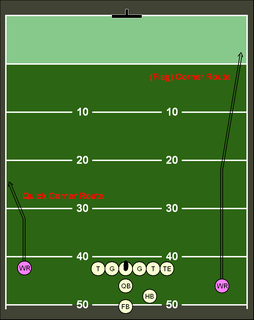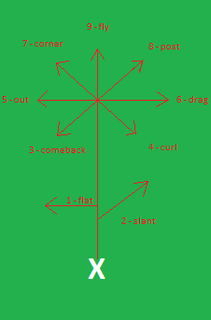
A cornerback (CB) is a member of the defensive backfield or secondary in gridiron football. Cornerbacks cover receivers most of the time, but also blitz and defend against such offensive running plays as sweeps and reverses. They create turnovers through hard tackles, interceptions, and deflecting forward passes.
A wide receiver, also referred to as wideouts or simply receivers, is an offensive position in gridiron football, and is a key player. They get their name because they are split out "wide", farthest away from the rest of the team. Wide receivers are the fastest players on the field. The wide receiver functions as the pass-catching specialist.
A screen pass is a play in gridiron football consisting of a short pass to a receiver who is protected by a screen of blockers. During a screen pass, a number of things happen concurrently in order to fool the defense into thinking a long pass is being thrown, when in fact the pass is merely a short one, just beyond the defensive linemen. Screens are usually deployed against aggressive defenses that rush the passer. Because screens invite the defense to rush the quarterback, they are designed to leave fewer defensemen behind the rushers to stop the play.
A draw play, or simply draw for short, is a type of American football play. The draw is a running play disguised as a passing play. It is the opposite of a play-action pass, which is a passing play disguised as a running play. The play is often used in long yardage situations.

A play-action pass is an American football play. The play action starts with what appears to be a running play, but turns out to be a pass play; in this way, it can be considered the opposite of a draw play. Play-action passes are often used against defenses that are focused on stopping the run. By initially simulating a running play, the offense attempts to deceive the defense into acting on the fake run and being out of position in their pass coverage, giving receivers more time and room to be free to receive passes behind the linebackers.
Strategy forms a major part of American football. Both teams plan many aspects of their plays (offense) and response to plays (defense), such as what formations they take, who they put on the field, and the roles and instructions each player are given. Throughout a game, each team adapts to the other's apparent strengths and weaknesses, trying various approaches to outmaneuver or overpower their opponent in order to win the game.
The hook and lateral is a trick play in American, Canadian football & indoor American football, often colloquially called the hook and ladder play.

A sweep is a running play in American football where a running back takes a pitch or handoff from the quarterback and starts running parallel to the line of scrimmage, allowing for the offensive linemen and fullback to get in front of him to block defenders before he turns upfield. The play is run farther outside than an off tackle play. Variants of the sweep involve the quarterback or a wide receiver running with the ball, rather than a running back.
A trick play, also known as a gadget play, gimmick play or trickeration, is a play in gridiron football that uses deception and unorthodox tactics to fool the opposing team. A trick play is often risky, offering the potential for a large gain or a touchdown if it is successful, but with the chance of a significant loss of yards or a turnover if not. Trick plays are rarely used not only because of the riskiness, but also to maintain the element of surprise for when they are used.

In American football each team has 11 players on the field at one time. The specific role that a player takes on the field is called their position. Under the modern rules of American football, teams are allowed unlimited free substitutions; that is, teams may change any number of players after any play, at any point in the game. This has resulted in the development of three task-specific "platoons" of players within any single team: the offense, the defense, and the so-called 'special team'. Within these three separate "platoons", various specific positions exist depending on what each player's main job is.

A fly route, also called a straight route, vertical route, streak route or go route, is a pattern run by a receiver in American football, where the receiver runs straight upfield towards the endzone. The goal of the pattern is to outrun any defensive backs and get behind them, catching an undefended pass while running untouched for a touchdown. Generally, the fastest receiver on the team or any receiver faster than the man covering him would be the one to run these routes. When run down the sidelines, a fly can be called a fade route.

An out route is a pattern run by a receiver in American football. On an out route, the receiver will start running a fly pattern but, after a certain number of steps, will cut hard 90 degrees "to the outside", or toward the sideline, away from the quarterback. If the cut comes very quickly, usually after only a few steps, it is called a "quick out". Out routes generally allow a one-on-one match-up between the receiver and the defensive back who is guarding him, as safeties generally are concerned with helping out on long routes downfield or the center of the field.

A corner route is a pattern run by a receiver in American football, where the receiver runs up the field and then turns at approximately a 45-degree angle, heading away from the quarterback towards the sideline. Usually, the pass is used when the defensive back is playing towards the inside shoulder of the receiver, thus creating a one on one vertical matchup. The corner route is less likely to be intercepted when compared to the slant route, because it is thrown away from the middle of the field. The pass is used frequently in the West Coast offensive scheme, where quick, accurate throwing is key. The pass may also be used closer to the goal line in what is called a "fade". The quarterback will lob the ball over a beaten defender to a wide receiver at the back corner of the end zone.
In American football a play is a close to the ground "plan of action" or "strategy" used to move the ball down the field. A play begins at either the snap from the center or at kickoff. Most commonly plays occur at the snap during a down. These plays range from basic to very intricate. Football players keep a record of these plays in their playbook.
In American football, Air Coryell is the offensive scheme and philosophy developed by former San Diego Chargers coach Don Coryell. The offensive philosophy has been also called the "Coryell offense" or the "vertical offense".

Zone coverage is a defense scheme in gridiron football used to protect against the pass.
The following terms are used in American football, both conventional and indoor. Some of these terms are also in use in Canadian football; for a list of terms unique to that code, see Glossary of Canadian football.

A flat route is an American football route, used in passing plays. A flat route is usually run by a running back or a fullback. When run by a receiver it can be known as a speed out or arrow route. The eligible receiver runs parallel to the line of scrimmage till near the sidelines and turns toward the quarterback to wait for the pass. The QB's pass should arrive when he is not yet past the line of scrimmage. The receiver will then turn upfield at the sideline and run straight down the field.
A play calling system in American football is the specific language and methods used to call offensive plays.

A route is a pattern or path that a receiver in gridiron football runs to get open for a forward pass. Routes are usually run by wide receivers, running backs and tight ends, but other positions can act as a receiver given the play.










